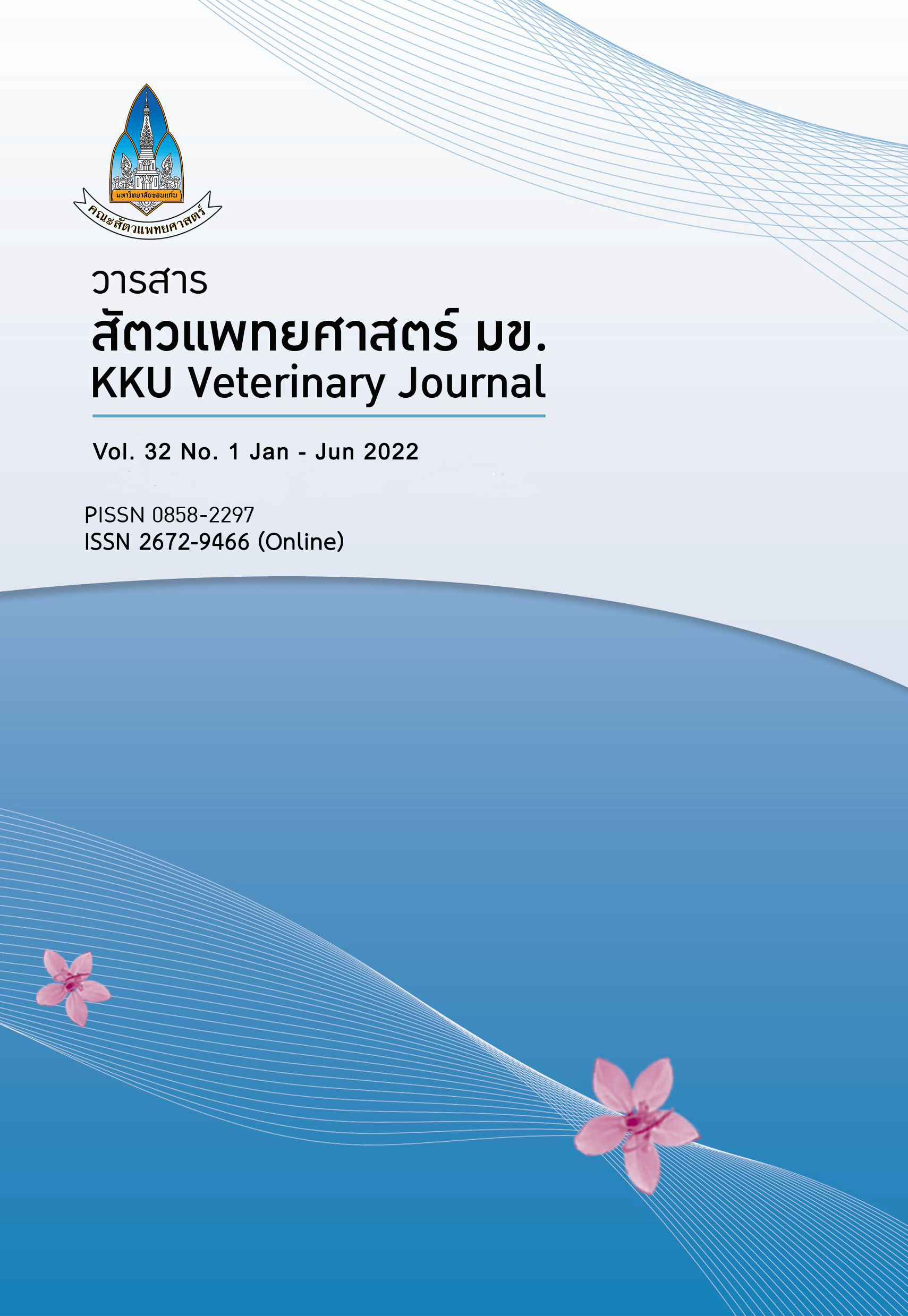ยาต้านจุลชีพตกค้างในเนื้อไก่และตับที่จำหน่ายใน 6 จังหวัดภาคตะวันออกเฉียงเหนือโดยการตรวจแบบคัดกรองด้วย CM-Test และ RR-test®
Main Article Content
บทคัดย่อ
วัตถุประสงค์: เพื่อสำรวจยาต้านจุลชีพตกค้างในเนื้อไก่จากฟาร์มไก่เนื้อที่ผ่านการรับรองมาตรฐานฟาร์มที่วางจำหน่ายในตลาด 6 จังหวัดของภาคตะวันออกเฉียงเหนือ และตัวอย่างเนื้อไก่เเละตับไก่จากฟาร์มรายย่อยที่จำหน่ายในตลาดเมืองขอนแก่น
วัสดุอุปกรณ์และวิธีการ: เก็บตัวอย่างเนื้อไก่เลี้ยงโดยฟาร์มมาตรฐานที่วางจำหน่ายในตลาด ในช่วงเดือนสิงหาคม ถึงเดือนกันยายน 2561 รวมทั้งสิ้น 600 ตัวอย่าง ในพื้นที่ 6 จังหวัดของภาคตะวันออกเฉียงเหนือคือ อุดรธานี นครราชสีมา อุบลราชธานี ศรีสะเกษ มุกดาหาร และขอนแก่น จังหวัดละ 100 ตัวอย่าง และเก็บตัวอย่างเพิ่มเติมอีก 50 ตัวอย่าง ในช่วงเดือนธันวาคม 2561 คือตัวอย่างเนื้อไก่ (n=25) และตับ (n=25) ที่ผลิตโดยฟาร์มรายย่อย ที่วางจำหน่ายในตลาดเมืองขอนแก่น ทำการวิเคราะห์ตัวอย่างด้วยชุดตรวจสำเร็จรูป CM-Test และ RR-test® ที่ใช้หลักการยับยั้งเชื้อแบคทีเรีย
ผลการศึกษา: ไม่พบยาปฏิชีวนะตกค้างในเนื้อไก่จากฟาร์มมาตรฐานที่วางจำหน่ายในตลาด 6 จังหวัดภาคตะวันออกเฉียงเหนือ แต่พบในตัวอย่างเนื้อไก่เเละตับไก่จากฟาร์มรายย่อย ที่วางจำหน่ายในเขตอำเภอเมือง จังหวัดขอนแก่น ให้ผลบวกร้อยละ 28 (14/50) โดยพบในตับไก่ (ร้อยละ 44) มากกว่าเนื้อไก่ (ร้อยละ 12) จากตัวอย่างที่ให้ผลบวกคิดเป็นสัดส่วนยากลุ่มเตตราไซคลีนเท่ากับร้อยละ 4 เเละกลุ่มแมคโครไลด์-อมิโนไกลโคไซด์-ซัลโฟนาไมด์ เท่ากับร้อยละ 24
ข้อสรุป: ตัวอย่างจากฟาร์มรายย่อย ที่วางจำหน่ายในตลาดเมืองขอนแก่น มีอัตราการตรวจพบยาต้านจุลชีพตกค้างในตับไก่สูงว่าในเนื้อไก่ แม้ว่าจะไม่มีความแตกต่างกันทางสถิติ การบริโภคตับไก่จึงมีความเสี่ยงที่จะรับยาปฏิชีวนะตกค้างมากกว่าเนื้อไก่ จากผลการศึกษานี้ ควรควบคุมติดตามการใช้ยาของฟาร์มรายย่อย เพื่อป้องกันปัญหายาต้านจุลชีพตกค้างในเนื้อไก่และเครื่องในต่อไป
Article Details

อนุญาตภายใต้เงื่อนไข Creative Commons Attribution-NonCommercial-NoDerivatives 4.0 International License.
เอกสารอ้างอิง
Chalermchaikit T, Poonsook K, Dangprom K, Lertworapreecha M, Jotisakulratana K, 2002. Efficiency of antimicrobial residue screening test kit for meat “CM-Test”. Agricultural Sci J 33:6 (Suppl.), 376-379.
Chalermchaikit T, Lertworapreecha M, Poonsook K, Lertworapreecha N, Srisanga S, Jotisakulratana K, 2003. “CM-Test” (Clean Meat-Test): The new antimicrobial residue screening test kit in meat. The 11th International Symposium of the World Association of Veterinary Laboratory Diagnosticians and OIE Seminar on Biotechnology, November 9-13.
Department of Medical Sciences, Ministry of Public Health, 2018. Test kit for antimicrobial residual detection in milk and milk products. [Cited 2022 July 28]. Available from: http://testkit.dmsc.moph.go.th/page-view/110
Department of International Trade, Ministry of Commerce, Thailand, 2021. Broiler situation. [Cited 2022 July 28]. Available from: http://agri.dit.go.th/index.php/department_doc/6/
Ferdous MRA, Ahmed MR, Khan SH, Mukta MA, Anika TT, Hossain MT, Islam MZ, Rafiq K, 2020. Effect of discriminate and indiscriminate use of oxytetracycline on residual status in broiler soft tissues. Vet World 13, 61–67. https://doi.org/10.14202/vetworld.2020.61-67
Hussein MA, Ahmed MM, Morshedy AM, 2016. Effect of cooking methods on some antibiotic residues in chicken meat. Jpn J Vet Res 64, S225–S231.
Lekagul A, Tangcharoensathien V, Mills A, Rushton J, Yeung S, 2020. How antibiotics are used in pig farming: A mixed-methods study of pig farmers, feed mills and veterinarians in Thailand. BMJ Glob Heal 5, 1918. https://doi.org/10.1136/bmjgh-2019-001918
Muaz K, Riaz M, Akhtar S, Park S, Ismail A, 2018. Antibiotic residues in chicken meat: Global prevalence, threats, and decontamination strategies: A review. J Food Prot 81, 619–627. https://doi.org/10.4315/0362-028X.JFP-17-086
Mund MD, Khan UH, Tahir U, Mustafa BE, Fayyaz A, 2017. Antimicrobial drug residues in poultry products and implications on public health: A review. Int J Food Prop 20, 1433–1446. https://doi.org/10.1080/10942912.2016.1212874
Nakrintr C, Chatsuparp A, 2002. Detection of antibiotic residues in pork, beef, and chicken meat in Chaiyaphum province. Independent study. Chaiyaphum Provincial Livestock Office.
Open-Source Epidemiologic Statistics for Public Health, Version 3.01, 2013. [Cited 2018 June 20]. Available from: https://www.openepi.com/Menu/OE_Menu.htm
Sarker YA, Hasan MM, Paul TK, Rashid SZ, Alam MN, Sikder MH, 2018. Screening of antibiotic residues in chicken meat in Bangladesh by thin layer chromatography. J Adv Vet Anim Res 5, 140–145. https://doi.org/10.5455/javar.2018.e257
Shahbazi Y, Ahmadi F, Karami N, 2015. Screening, determination, and confirmation of tetracycline residues in chicken tissues using four-plate test, ELISA and HPLC-UV methods: comparison between correlation results. Food Agric Immunol 26, 821–834. https://doi.org/10.1080/09540105.2015.1036357
Sichilongo KF, Muckoya VA, Nindi MM, 2015. A Rapid and Sensitive LC-MS/MS Method for the Determination of Multi-class Residues of Antibiotics in Chicken Liver. South African J Chem. 68. https://doi.org/10.17159/0379-4350/2015/v68a1
Smart Buying magazine, 2018. Monitoring of goods and services for protecting of consumers’ health. [Cited 2022 July 28]. Available from https://embed.voicetv.co.th/read/SyRlJ0A7Q
Thi N, Thi N, Van B, Cuong N, Van TT, Duong Q, 2018. Antimicrobial residues and resistance against critically important antimicrobials in non-typhoidal Salmonella from meat sold at wet markets and supermarkets in Vietnam. Int J Food Microbiol 266, 301–309. https://doi.org/10.1016/j.ijfoodmicro.2017.12.015
Xu L, Wang W, Xu W, 2022. Effects of tetracycline antibiotics in chicken manure on soil microbes and antibiotic resistance genes (ARGs). Environ Geochem Health 44. https://doi.org/10.1007/s10653-021-01004-y


